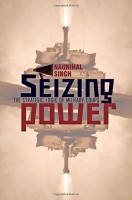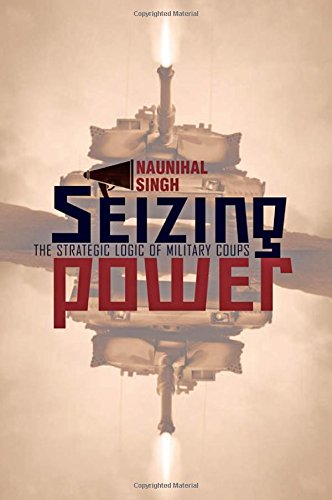 Author: Naunihal Singh
Author: Naunihal Singh
Publisher: Johns Hopkins University Press – 252 pages
Book Review by: Paiso Jamakar
This is a treasure trove of data and analysis of hundreds of coups, including close observations of ten of them. From the activities we spell out below, Nauninal Singh draws conclusions on the causes and outcomes of coups and coup attempts, and has developed a unified theory on coup dynamics. The body of information he gathered for this book came from these empirical sources:
- 471 coup attempts worldwide in half a century 1950 to 2000.
- 300 hours of interviews with coup participants
- 10 coups in Ghana, from 1967 to 1981, examined closely
- 3 days of the 1991 USSR coup that changed the world
We show you below how Singh has compiled, organized and presented his research in his book on the contents pages. At the end of each chapter is a page-long (or longer) Conclusion, which enables those interested, to study quickly the causes and effects, and other aspects of coups.
- Introduction
- The Importance of Understanding Coups
- Understanding Coup Outcomes and Dynamics
- Other Theoretical Explanations
- Background of Cases
- Overview of Chapters
- Theory
- Coups as Battles
- Coups as Elections
- Coups as Coordination Games
- Counting Coups
- Understanding Coup Attempts
- Understanding Coup Outcomes
- Understanding Coup Levels
- Limitations
- Coups from the Top of the Military
- A Theory of Coups from the Top
- The Case of Ghana, 1975
- Coups from the Middle
- A Theory of Coups from the Middle
- Ghana, 1967
- Ghana, 1972
- Coups from the Bottom
- A Theory of Coups from the Bottom
- Ghana, May 1979
- Ghana, June 1979
- Ghana, 1981
- USSR, 1991: Three Days that Changed the World
- Background
- Analysis
- Conclusion
- Implications for the Study of Civil-Military Relations
- Implications for Future Coups
- Implications for Policy
Singh writes that his study of literature (of which there is very little out there) on the dynamics of coups and outcomes of coup attempts, shows that there are basically two explanations offered:
- Coups as Battles: Miniature invasions of the country by its own armed forces whose outcomes are determined by tactical dominance. When the coup leaders are stronger than the incumbent and able to establish control over key military target, and suppress opposition, they win.
- Coups as Elections: Referendums on the continued rule of the incumbent, a metaphorical plebiscite or vote of no confidence taken within the military. Challengers win when the government is unpopular within the military, either because the incumbent has alienated the citizenry at large, or because its policies have antagonized members of the armed forces in particular.
But based on his extensive fieldwork (hundreds of interviews with those who fought in coups; speaking to leaders and others in the ten Ghana coups as part of his close examinations of these and the 1991 coup in the Soviet Union), Singh offers a third theory he calls coordination games within the military.
What his research has shown is that during each military coup attempt, the actors want to be on the same side as everyone else. In other words, a consensus had been found within the potential coup participants by the coup leaders, and they are making the coup attempt based on that joint verbal agreement.
This is truly an insightful book on a subject – coups as a means of seizing power – that has been little researched and written about. Naunihal Singh is a true pioneer in that regard, and we must commend him for making a unique contribution to military knowledge with this important, highly useful, and valuable book.
Naunihal Singh is an assistant professor of international security studies at the Air War College in Alabama.







